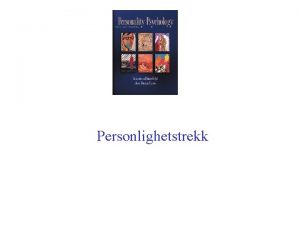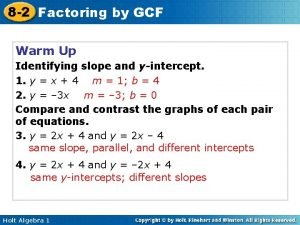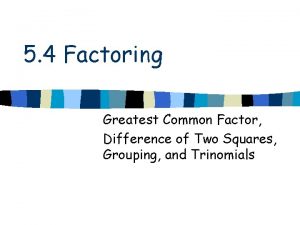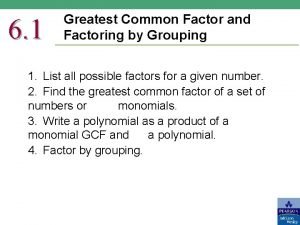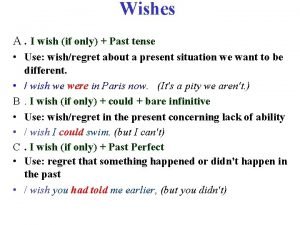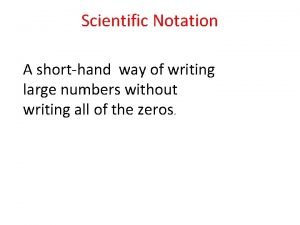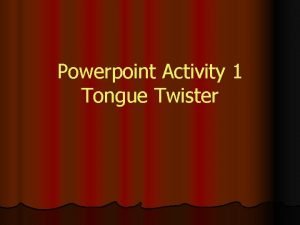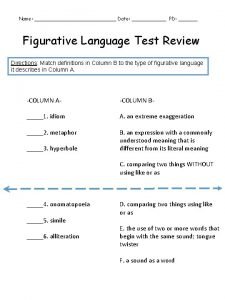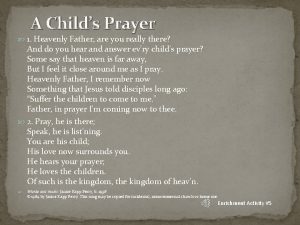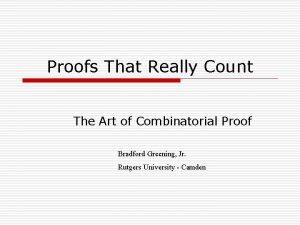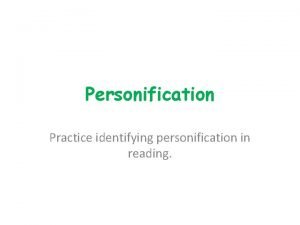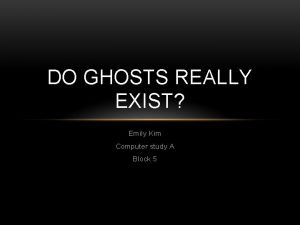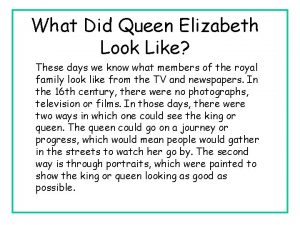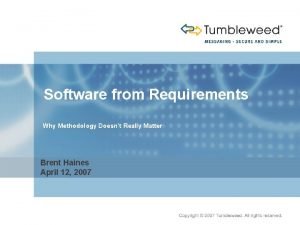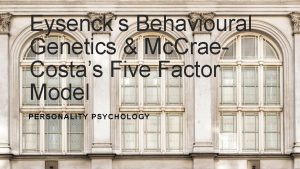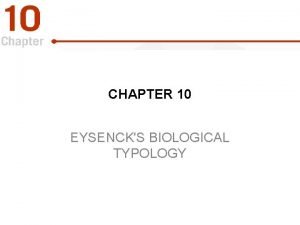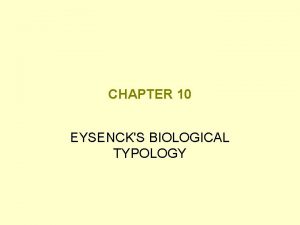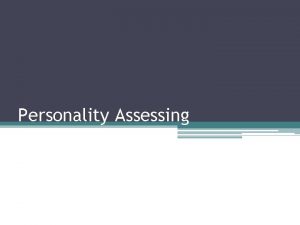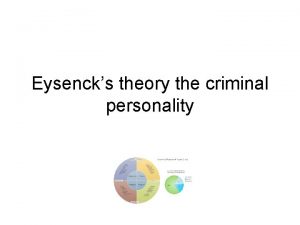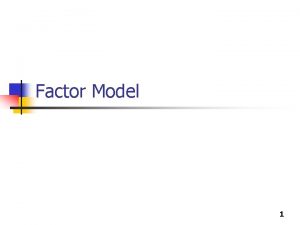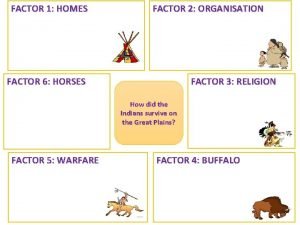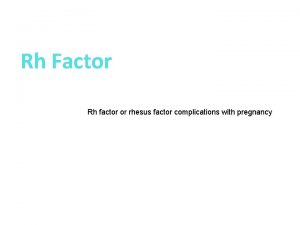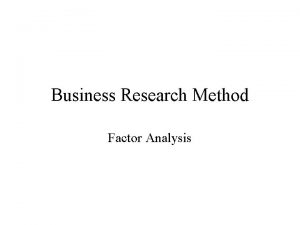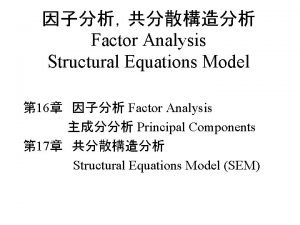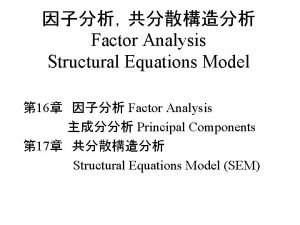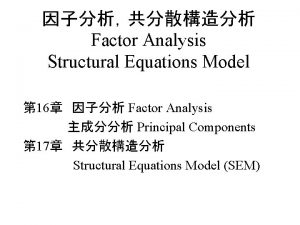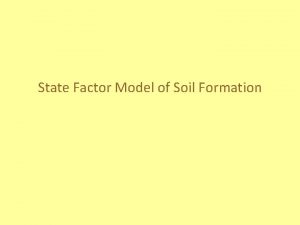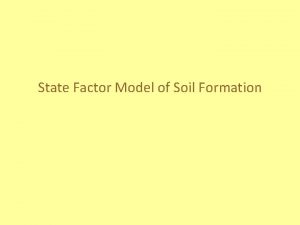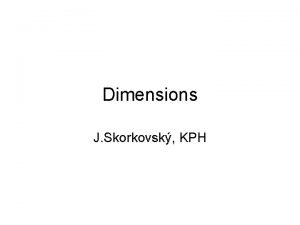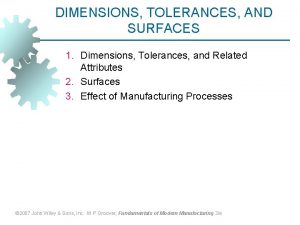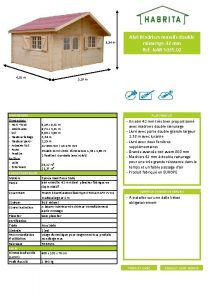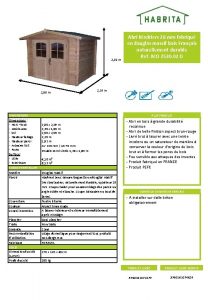Eysencks 3 Factor Model The really important dimensions












































































- Slides: 76

Eysenck’s 3 -Factor Model The really important dimensions will be 1. highly heritable 2. have a neurological substrate 3 dimensions met these criteria: Extraversion Neuroticism Psychoticism E N P

Psychoticism P ● Lacking empathy ● Often cruel and inhumane (hurt animals) ● Often act very aggressively ● Prone to impulsive behavior ● Irresponsible, disorganized Eysenck strongly favored the label ● Can show odd, strange behavior Psychoticism , however that label was ● Antisocial tendencies (criminality) always controversial. Some proposed that Psychopathy was closer to what Eysenck’s P questionnaire was measuring.

Criticism of PEN model Criticism of Eysenck PEN model 1) Heritability? ● Many traits are heritable. 2) Neurological substrates? ● Neuroscience ideas are premature. 3) PEN is not comprehensive ● Missing some big dimensions

Cattell’s “ 16 PF” Trait Taxonomy Cattell’s “ 16 PF” Quest: ● Identify and measure all of the basic units of personality Criterion of basicness? ● Replicability across data sources (LOTS, e. g. , finding same factors in self-reports vs. observer ratings)

Cattell’s “ 16 PF” Taxonomy Cattell’s Taxonomy: 16 PF Approach ● Lexical Sample Allports 28, 000 ● Statistical Data (self-ratings). Factor analysis of correlations. ● Converging evidence across data sources (LOTS)

Cattell’s “ 16 PF” Taxonomy Cattell’s Taxonomy Criticisms 1. Failure to replicate the 16 2. Many argue # factors is much smaller than 16

Criticism: Too many factors ? Dominance Boldness Impulsivity Extraversion ?

Costa & Mc. Crae (1976) l Factor analysis of 16 PF l No support for 16 factors. l Concluded 16 PF is measuring 3 very big dimensions.

N E O ?

Costa & Mc. Crae (1976) 3 big factors in 16 PF. Two were familiar (E, N). One was new (O). Neuroticism Extraversion Openness to Experience NEO Personality

The Interpersonal Traitof Interpersonal Domain. Traits Taxonomy Leary Wiggins

Interpersonal Traits Interpersonal traits l Traits that require interaction Bold, timid, kind, cold, hostile, sociable, aloof, polite, deferent, agreeable. Non-interpersonal traits l Don’t require interaction organized, neat, messy, nervous, gloomy, jolly, curious, irritable.

Assertive Dominant Manipulative Coldhearted Aloof Introverted Timid Submissive Agreeable Warmhearted Sociable Extraverted

Interpersonal Circle Assertive Dominant Extraverted Manipulative Affiliative Cold Warm Aloof Agreeable Introverted Deferent Timid

Dominance Assertive Dominant Extraverted Affiliative Cold Warm Aloof Agreeable Introverted Deferent Timid Warmth Manipulative

Timothy Leary LSD “Guru” 1960 s Counterculture & Antiwar Movement

Dom Love

Dominance (IPC) Warmth Interpersonal Circumplex

Wiggins-Leary Circumplex Model ● Circular continuum of meaning. . . ● around LOVE and POWER ● Interpersonal traits are traits involving… social resource exchange

Power or Dominance Assertive Dominant Extraverted Affiliative Cold Warm Aloof Agreeable Deferent Introverted Timid Love or Warmth Manipulative

The Wiggins-Leary Circumplex Advantages 1. Specifies the expected association among all interpersonal traits

Assertive Dominant Cold Adjacency Bi po lar ity Manipulative Extraverted Aloof Affiliative Or tho go na lity Introverted Warm Agreeable Deferent Timid

The Wiggins-Leary Circumplex 2. Alerts investigators to gaps in coverage of interpersonal traits 3. Improves integration of research findings. e. g. , Bem Inventory Sex Role

Sandra Bem (1944 -2014) ● Influential gender theorist ● Gender Schema Theory Gender role socialization ● New method of measuring masculinity-femininity Bem Sex-Role Inventory ● Indicates how gender “schematic” you are. New York Times Magazine, May, 2015

Traditional concept of Masculinity-Femininity M Prior to Bem (1974) F ● Masc and Fem were opposite qualities. ● You cannot be feminine and masculine. ● That seemed to fit ordinary intuitions about what masculine and feminine meant.

Bem (1974) Q: How to measure masculinity & femininity? ● Identify traits regarded more culturally desirable for one gender or the other. Men? ● Dominant, Bold, Competitive, etc. Women? ● Sympathetic, Kind, Tender, etc.

Sandra Bem (1974) ● Masc and Fem are two things. ● People come in M M all combinations. ● Gender roles simply mask this true picture of men and women. F F

Q: Why were Bem’s Masc and Fem scales orthogonal (uncorrelated)? BSRI Masc = Bold, assertive. . . BSRI Fem = Kind, caring… Hint: Where are these two groups of traits on the Interpersonal Circumplex?

M Assertive Dominant Manipulative Extraverted Affiliative F Cold Warm Aloof Agreeable Introverted Deferent Timid

Q: What about negative (-) masculine traits and negative (-)feminine traits? (-)Masc = Cold, insensitive. . . (-)Fem = Timid, helpless… Where are THOSE two groups of traits on the Interpersonal Circumplex?

Assertive Dominant Extraverted Manipulative Affiliative M Warm Aloof Agreeable Cold Introverted F Timid Deferent

M M Assertive Dominant Manipulative Extraverted Affiliative M F Aloof Agreeable Cold Introverted Warm F Timid Deferent F

M Assertive Dominant Manipulative Extraverted Affiliative F Cold Warm Aloof Agreeable Introverted Deferent Timid

M Assertive Dominant Extraverted Manipulative Affiliative Cold Warm Aloof Agreeable Introverted Deferent Timid F

Bem’s Androgyny Theory H ig he st W el l-b ei ng

M Assertive Dominant Manipulative Cold Extraverted Affiliative F Warm The Leary-Wiggins Circumplex model implies Aloof Agreeablethat Bem’s androgenous persons were likely to have been extraverts, which explains why her Introverted Deferent androgeous group typically reported the highest Timid levels of well-being—Extraverts tend to report especially high levels of positive emotions.

Benefits of the IPC Model ● This illustrates the benefits of referring trait concepts and measures to general structural models of trait covariation. ● Bem’s core findings with the Bem Sex Role Inventory (BSRI) would have been anticipated from the relations well summarized by the interpersonal circumplex model (not published by Wiggins until 1979).

History of Big Five Model Comprehensive Models of Traits? ● Eysenck’s PEN ? -- No. ● Leary-Wiggins Circumplex ? -- No. ● Cattell’s 16 PF ? -- No. (-) Procedural ambiguities. (-) Very small #variables measured. (-) No cross-cultural replications.

Lexical discovery of the Big 5 Lewis Goldberg (1980 s) l Redo steps of Cattell Large scale factor Analyses easy now l 1710 adjectives self-ratings, peer-ratings l Result: 5 broad dimensions l What about other languages? German, Dutch, French, Turkish, Tagalog… l Same result: Big Five

The OCEAN of Personality Extraversion Neuroticism Conscientiousness Agreeableness Openness-Intellect E N Eysenck ’s P?

The Big Five O C EA N Sociability Warmth Pos emotions Assertiveness Excitement-skg Activity-level Each factor represents covariation among hundreds of related traits. 5 Dimensions of Trait Covariation

Extraversion Is full of energy. Has an assertive personality. Is outgoing, sociable. Is talkative. Generates a lot of enthusiasm. Is sometimes shy, inhibited. Tends to be quiet. Is reserved.

Agreeableness Is helpful and unselfish with others. helpful Is generally trusting. Has a forgiving nature. forgiving Likes to cooperate with others. Is sometimes rude to others. (-) Starts quarrels with others. (-) Can be cold and aloof. (-)

Conscientiousness Does a thorough job Is a reliable worker Perseveres until the task is finished Does things efficiently Makes plans and follows through with them Tends to be disorganized (-)

Neuroticism Is depressed, blue. Worries a lot. Gets nervous easily. Can be moody. Is relaxed, handles stress well. (-) Remains calm in tense situations. (-)

Openness to Experience Is curious about many different things. Has an active imagination. Values artistic, aesthetic experiences. Likes to reflect, play with ideas. Is original, comes up with new ideas. Is ingenious, a deep thinker. Is inventive.

Big Five Aspects Questionnaire O I Enjoy the beauty of nature. Believe in the importance of art Love to reflect on things. Get deeply immersed in music. See beauty in things that others might notice. Am quick to understand things. Can handle a lot of information. Like to solve complex problems. Have a rich vocabulary. Think quickly. Formulate ideas clearly. Jordan Peterson

Why is Big Five important? 1. Comprehensive (cont’d) l Also located in old trait questionnaires. e. g. , MMPI, CPI, 16 PF Example: MBTI Myers-Briggs Type Indicator

Costa and Mc. Crae

MTBI correlations with B 5 OCEAN I-S. 72. 50 J-P. 74 E-I. 44 F-T ?

Are the Big Five related to the Leary-Wiggins Circumplex Model? The Wiggins Circumplex has two underlying dimensions, DOM and LOV. Which 2 Big Five dimensions correspond to the underlying two dimensions of the Leary-Wiggins Circumplex?

Dominance Assertive Dominant Extraverted Affiliative Cold Warm Aloof Agreeable Introverted Deferent Timid Warmth Manipulative

Ext rav Assertive Dominant Extraverted Manipulative Affiliative Cold Warm Ag re Aloof Agreeable Introverted Deferent Timid

Can the Big Five Explain Sigmund Freud’s Character Freud's character types: Types? Freud’s Character Types Big Five Personality Dimensions Oral Anal Genital Phallic Extrav ? Consc ? (Dis)-Agree ? Openness ?

Ignore the slides after this one unless we covered them in class. Only slides we cover in class are relevant material in the course. Therefore, you can ignore any slides after this point that were NOT covered in class.

2. Cross-cultural univers. Found in many languages l Many languages other than European (although the clearest replications are in European languages) Translated Big Five questionnaires show same structure worldwide l NEO-PIR studied in hundreds of languages NEO-PIR l Factor structure recovers Big Five very closely in all samples

3. Very stable over time Self-reports Big Five GZTS MMPI Si Peer-reports Big Five r Interval 6 years 24 years 30 years . 74. 65. 56. 70 7 years . 70

4. Strong heritability Weight IQ . 60. 50 Openness Extraversion Neuroticism Conscientiousness Agreeableness . 46. 31. 28

5. Predict important things l Physical Health Substance abuse (e. g. , low C, high N, high O) Longevity (e. g. high C) l l l Psychological health (e. g. , low N, high E, high C) Close relationships / divorce (e. g. , high N) Career preferences (e. g. , openness and extrav) Political preferences (e. g. , openness) Music preferences (e. g. , openness, extraversion) Lifestyle leisure interests… clothing… tattoos (!)

Neuroticism Well-being and Personality Depression

Openness Politics and Personality

Beyond the Big Five? Possible omissions: 1. 2. 3. 4. 5. 6. Pos eval “good”, excellent” Neg eval “evil”, “awful” masc/fem “girlish” relig & spiri “religious” attractiveness “beautiful” Sexuality “sexy”

Big Five Controversies 1. Is Factor V Opns or Intellect? l The fifth Big Factor isn’t identical across different languages. 2. Maybe a “Big Six”model is better than a Big Five model? l Lee and Ashton (2008) propose a “HEXACO” model of personality. They found support for it in re-analysis of many lexical studies of different languages.


The Structure of Turkish Trait Adjectives E C A N Source: Somer and Goldberg (1999)

Turkish Factor V: Openness to Experience Open to experience Open-minded Modern, progressive Likes reading Source: Somer and Goldberg (1999)

French Factor V: Openness to Experience Passionate Revolutionary Unconventional Eccentric Source: Ashton et al. (2001)

Factor V… Openness? French Dutch Turkish Artistic, passionate, curious imaginative, open-minded, liberal, unconventional… Factor V… Intellect? German Hungarian Tagalog Intelligent, intellectual, clever, smart, perceptive, observant, knowledgeable…

The Big “Six” instead? HEXACO model l l l Agreeableness is too broad? Easily breaks into 2 big dimensions 6 th factor: Honesty-Humility [H-H] Many languages show this 6 th factor Big Six is better? Currently being debated. (Many disagree). l H-H tend to be very strongly inversely correlated with psychopathy (r = -. 70 )

HEXACO model Agreeableness l (+)Gentle, Peace-loving, Patient l (-)Aggressive, (-)touchy Honesty-Humility l (+)Sincere, Honest, Just l (-)Boastful, (-)Dishonest. (-)Greedy

Lexical “Big Three” De Raad et al. (2014)

De Raad et al. (2014) Agreeableness Emotional Stability Conscientiousness Extraversion Big Fiv e. M od el Intellect. Openess HE XA O C Int-Opn

The AB 5 C Model AB 5 C = Abridged Big Five Circumplex Wiggins-Leary IPC B 5 Factor 1 and 2 B 5 Factor 3 and 4

AB 5 C Trait Taxonomy Abridged Big Five Circumplex (AB 5 C) AB 5 C = 10 two-dimensional circumplexes created for all possible pairs of Big Five A 2 -dimensional circumplex can be proposed for any pair of Big Five factors.

Consc Organized Reliable Smart Competent Curious Original Unreflective Incurious Lax Incompetent Disorganized Careless Day-dreamy Imaginative Opns Practical Down-toearth

Consc Organized Obsessive Disciplined Erratic Laid-back Disorganized Neur Anx Calm
 Eysencks model
Eysencks model Internalitet
Internalitet From most important to least important in writing
From most important to least important in writing From most important to least important in writing
From most important to least important in writing Least important to most important
Least important to most important Factoring in algebra
Factoring in algebra Factor out the greatest common factor
Factor out the greatest common factor Power of sine wave
Power of sine wave Factor isolating question research question
Factor isolating question research question What is factored form
What is factored form Common factors of 60 36 and 48
Common factors of 60 36 and 48 Hát kết hợp bộ gõ cơ thể
Hát kết hợp bộ gõ cơ thể Slidetodoc
Slidetodoc Bổ thể
Bổ thể Tỉ lệ cơ thể trẻ em
Tỉ lệ cơ thể trẻ em Voi kéo gỗ như thế nào
Voi kéo gỗ như thế nào Tư thế worm breton
Tư thế worm breton Hát lên người ơi alleluia
Hát lên người ơi alleluia Các môn thể thao bắt đầu bằng tiếng chạy
Các môn thể thao bắt đầu bằng tiếng chạy Thế nào là hệ số cao nhất
Thế nào là hệ số cao nhất Các châu lục và đại dương trên thế giới
Các châu lục và đại dương trên thế giới Công thức tính thế năng
Công thức tính thế năng Trời xanh đây là của chúng ta thể thơ
Trời xanh đây là của chúng ta thể thơ Mật thư tọa độ 5x5
Mật thư tọa độ 5x5 Phép trừ bù
Phép trừ bù Phản ứng thế ankan
Phản ứng thế ankan Các châu lục và đại dương trên thế giới
Các châu lục và đại dương trên thế giới Thể thơ truyền thống
Thể thơ truyền thống Quá trình desamine hóa có thể tạo ra
Quá trình desamine hóa có thể tạo ra Một số thể thơ truyền thống
Một số thể thơ truyền thống Cái miệng nó xinh thế
Cái miệng nó xinh thế Vẽ hình chiếu vuông góc của vật thể sau
Vẽ hình chiếu vuông góc của vật thể sau Biện pháp chống mỏi cơ
Biện pháp chống mỏi cơ đặc điểm cơ thể của người tối cổ
đặc điểm cơ thể của người tối cổ Ví dụ về giọng cùng tên
Ví dụ về giọng cùng tên Vẽ hình chiếu đứng bằng cạnh của vật thể
Vẽ hình chiếu đứng bằng cạnh của vật thể Tia chieu sa te
Tia chieu sa te Thẻ vin
Thẻ vin đại từ thay thế
đại từ thay thế điện thế nghỉ
điện thế nghỉ Tư thế ngồi viết
Tư thế ngồi viết Diễn thế sinh thái là
Diễn thế sinh thái là Dot
Dot Các số nguyên tố là gì
Các số nguyên tố là gì Tư thế ngồi viết
Tư thế ngồi viết Lời thề hippocrates
Lời thề hippocrates Thiếu nhi thế giới liên hoan
Thiếu nhi thế giới liên hoan ưu thế lai là gì
ưu thế lai là gì Khi nào hổ con có thể sống độc lập
Khi nào hổ con có thể sống độc lập Sự nuôi và dạy con của hươu
Sự nuôi và dạy con của hươu Hệ hô hấp
Hệ hô hấp Từ ngữ thể hiện lòng nhân hậu
Từ ngữ thể hiện lòng nhân hậu Thế nào là mạng điện lắp đặt kiểu nổi
Thế nào là mạng điện lắp đặt kiểu nổi Spiral model has two dimensions
Spiral model has two dimensions 7d cultural dimensions model
7d cultural dimensions model Dimensions of learning marzano
Dimensions of learning marzano If only present tense
If only present tense Scientific notation
Scientific notation What leaders really do hbr
What leaders really do hbr Tell us about a film you really like
Tell us about a film you really like Scientific notation is a shorthand way of writing really
Scientific notation is a shorthand way of writing really Volta in remains
Volta in remains Tongue twister about spring
Tongue twister about spring It really burned me up when you yelled at me.
It really burned me up when you yelled at me. A marketer can really satisfy everyone in the
A marketer can really satisfy everyone in the Heavenly father are you really there
Heavenly father are you really there Heavenly father are you really there
Heavenly father are you really there Have you really tried to save gas poster meaning
Have you really tried to save gas poster meaning Proofs that really count
Proofs that really count The gentle wind softly kissed my cheeks
The gentle wind softly kissed my cheeks Do ghosts really exist
Do ghosts really exist Breaking bad powerpoint template
Breaking bad powerpoint template Tell me whats really going on
Tell me whats really going on What was jesus really like
What was jesus really like What did elizabeth i really look like
What did elizabeth i really look like It's really fascinating
It's really fascinating Doesnt really matter
Doesnt really matter

